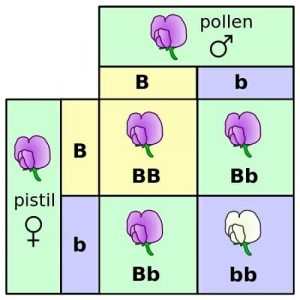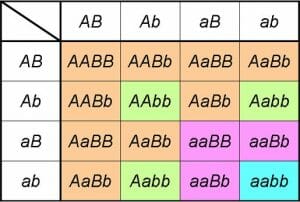The genotypic ratio shows the number of times a characteristic of an organism will be seen in the offspring when genes for certain traits are crossed. This more easily understood by using the Punnett square method and a basic monohybrid cross as shown in Figure 1.

Figure 1: The image above shows a Punnett square monohybrid cross of male and female pea plants that are both heterozygous dominant for purple. The genotypic ratio for this cross is written 1:2:1.
In animals and plants, each gene has 2 alleles or variations, one from each parent. When male and female gametes come together (cross) all the phenotype variations for the offspring are predicted using the Punnett square grid. The pairs of alleles for male and female are plotted individually on a grid. Then, each square in the grid is filled in with the corresponding combinations of alleles coming from the parents.
To find the genotypic ratio, count the number of times each combination appears in the grid, starting in the upper left square. The example in Figure 1 below is crossing alleles for just one trait, flower color. Larger Punnett squares are used to calculate genotypic ratios for more than one trait as shown in Figure 2.

Figure 2: The image above shows a Punnett square for figuring out the genotypic ratio using 4 traits from each parent. Reading the grid starting in the upper left square, the genotypic ratio is 1:2:2:1:4:1:2:2:1.
References
- Wilson, D. (2012). Punnett squares. Retrieved from lecture notes online. Website: http://sctritonscience.com/Wilson/biology_punnett_squares.htm
Genotypic Ratio
No comments:
Post a Comment